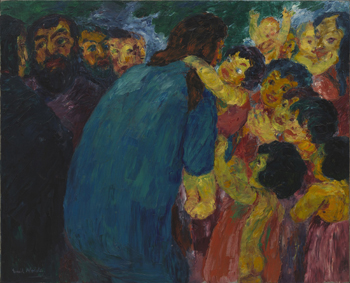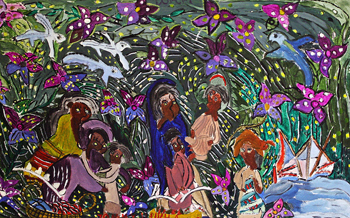For Sunday September 23, 2018
Lectionary Readings (Revised Common Lectionary, Year B)
Jeremiah 11:18-20
Psalm 54
James 3:13-4:3, 7-8a
Mark 9:30-37
For the past three years, I’ve had the privilege of directing the children’s ministry at the Episcopal church I attend in Palo Alto, California. Part of my work is administrative — I help organize seasonal events for families; purchase toys, books, and other materials for the nursery and the children’s chapel; and connect with parents and ministry volunteers over email or coffee. But the bulk of the work — the fun part — involves spending time with children. Sometimes this means reading board books to toddlers, or cuddling a screaming infant while his parents make a hopeful dash for Communion. At other times, it means building Lego towers with six-year-olds, asking a 5th grader which Harry Potter novel she’s up to, or fielding impossible questions about God, Jesus, and the Bible. (Some recent zingers include: “Where did the animals on Noah’s Ark go to the bathroom?,” “Are angels boys or girls?,” and “Did Jesus walk on water because he couldn’t swim?”
In this week’s Gospel reading, Jesus takes a little child into his arms, turns to his disciples, and says, “Whoever welcomes one such child in my name welcomes me, and whoever welcomes me welcomes not me but the one who sent me.” On the face of it, this tender gesture is so small and so straightforward, it’s easy to miss its import. But consider how radical a teaching this actually is for the disciples and for us. Jesus doesn’t say, “Welcome the child because it’s a loving or kind or ethical or socially beneficial thing to do. He says: Do you want to see what God actually looks like? Do you want to find God’s stand-in, hidden here among you? Are you curious about the truest nature of divine power and greatness? Then welcome the child. Welcome the child, and you welcome God.
 |
The context for this remarkable claim is an argument that breaks out among the disciples when Jesus explains — for the second time — that he will suffer, die, and rise again after three days. The disciples don’t understand a word Jesus says, but they’re too afraid to ask questions. Instead, they argue about who among them is the greatest. When Jesus asks what their quarrel is about, they refuse to answer; they're too embarrassed. But he knows, so he brings a child into their midst, gathers the child into his arms, and upends his disciples’ notions of greatness and power: “Whoever wants to be first must be last of all and servant of all.”
I’ve spent the past few days reflecting on the link Jesus makes between children and God, between childlikeness and God-likeness. I’ve done so both from the perspective of my work as a children’s minister, and as a parent. Perhaps if I didn’t have so much experience with children, I’d be tempted to sentimentalize the connection. I’ve heard well-meaning people suggest, for example, that Jesus likens children to God because children are so purely good, or unselfish, or accepting, or meek. Well, I don’t know children like that; the ones I know are far more interesting. They’re feisty, clever, quick, fierce, generous, selfish, naughty, obedient, curious, bored, quiet, loud, challenging, funny, surprising, solemn, and exhausting. I think Jesus knew as much when he described children as trustworthy representations of God.
So what are the connections? What can we learn about God by welcoming children? How can children open us up to deeper, more authentic communion with Jesus? This is by no means an exhaustive list; but here are some possibilities I’ve been mulling over:
- Children teach us to honor our imaginations as pathways to God. Every Sunday when I teach Children’s Chapel, I am amazed by the imaginative scope and power of young children. They can stack fifty Lego bricks together and see an entire city. They can cover a piece of construction paper in what looks to me like scribbles, and then tell a fully formed story based on the lines and squiggles. When I tell them Bible stories, they can fill in creative details using the full range of their senses — here’s what the perfume in the woman’s alabaster jar smelled like, here’s what Peter’s callused feet in Jesus’s hands felt like, here’s what the bread at the Last Supper tasted like. In this week’s lection, Jesus invites the disciples to imagine a world where death doesn’t have the final word. Where inexpressible suffering gives way to irrepressible joy. Where resurrection is not merely a possibility, but a promise. But the disciples can’t make the leap. They’re bound by preconceived notions of who and what the Messiah must be, and they lack the imagination to envision a world as revolutionary as the one Jesus holds out to them. Doctrine, dogma, and theology, in other words, hold their spiritual senses captive. Welcome the child, Jesus says in response. Open your imaginations. Return to the capacity for wonder, newness, and strangeness you knew as a child.
-
Children teach us to risk hard questions on our way to God. As I mentioned earlier, kids aren’t afraid to ask awkward, challenging, and even impossible questions. They’re naturally curious, they’re not embarrassed by their ignorance, and they’re willing to risk social discomfort to get to the truth. If they don’t understand something, they ask, and they persist in asking. In contrast, the disciples in this week’s Gospel story miss an opportunity to draw closer to Jesus, because they’re too afraid to ask hard questions. In telling them candidly about the suffering that lies in his future, Jesus offers his disciples the possibility of a deeper, more vulnerable-making intimacy with him. But they refuse the invitation, either because they don’t have the courage to admit their ignorance, or because they can’t bear to hear truths that might cause them pain. Perhaps they believe — as we so often do — that avoiding the uncomfortable stuff will save them. Whatever the case, their unwillingness to ask tough questions of themselves, of each other, and of Jesus limits their growth and their fellowship with God.
- Children teach us to trust God’s abundance. Young children generally expect that there’s enough to go around. Enough time, enough hugs, enough attention, enough love. (Also, enough Teddy Grahams, cheddar-flavored Goldfish, and Munchkin donuts!) It doesn’t occur to them to fear scarcity unless they’re conditioned to do so; left to themselves, they assume plenitude. In her memoir, The Cloister Walk, Kathleen Norris tells a beautiful story about Saint Thérèse of Lisieux. When Thérèse was four years old, she was shown a handful of colorful ribbons, and asked to choose one. Entranced, she simply responded, “I choose all.” The disciples in this week’s story, though, don’t believe that “all” is available in the kingdom of God. They don’t lean into Jesus’s generosity, sufficiency, and abundance. Believing that what’s available to them is meager and inadequate to start with, they quarrel for first place, first dibs, first prize. In response, Jesus points them to the non-striving, un-ambitious, open-hearted trust of a young child. As if to say: “Stop racing. Stop competing. Stop scrambling. There is enough. I am enough.”
-
And finally, children teach us what divine power looks like. This, I think, is the most radical lesson of the four. A young child is the very picture of helpless dependence, of powerlessness, of need. In some cultures, children are socially invisible. In others, they’re legally unprotected. In all cultures, children are at the mercy of those who are older, bigger, and stronger than they are. And this — this shocking portrait of dependence and vulnerability — is the portrait Jesus offers of God. In the divine economy, power and prestige accrue as we consent to be little, to be vulnerable, to be invisible, to be low. We gain greatness not by muscling others out of our way, but by serving them, empathizing with them, and sacrificing ourselves for their well-being. Whatever human hierarchies and rankings we cling to, Jesus upends as he holds a tiny child in his arms. Do we want to see God? Do we really want to see God? Then look to the child abandoned in the alleyway. Look to the child in detention at the U.S border. Look to the child a priest is molesting. Look to the child dying of gunshot wounds in his kindergarten classroom. Look to the child a parent is trafficking. Look to the child who can’t access healthcare, an education, or dinner. Look to the child drowning in anxiety and depression. Look to the weak, the small, the simple, the vulnerable, and the helpless. Look to the ones who are not in charge. Look at the tiniest faces, and see God.
One of the most central and amazing truths about Christianity is that God became a helpless human child. In this week’s Gospel story, Jesus underscores that stunning truth with another: all children everywhere represent God's heart, God's likeness, God's power. To welcome a child is to welcome the divine. To cultivate childlikeness is to cultivate Godliness. To consent to be little is to become great. Welcome the child.
Image credits: (1) Pinterest.com; (2) The Museum of Modern Art; and (3) FineArtAmerica.com.





